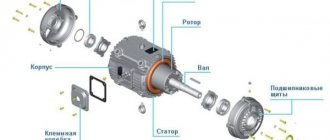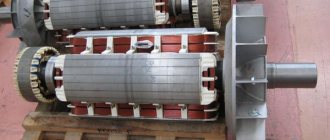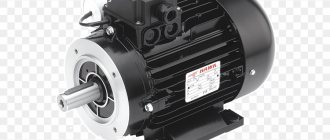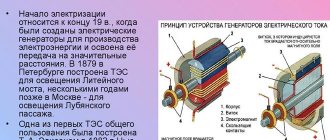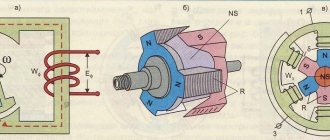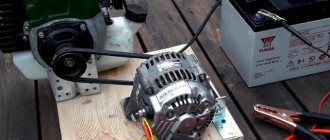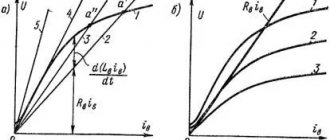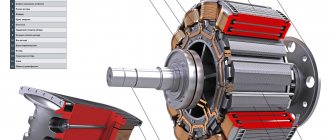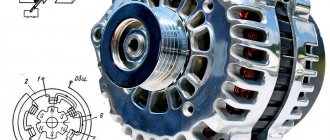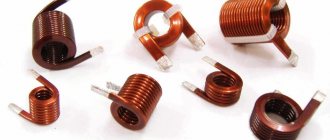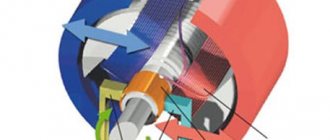Greetings to everyone on our website. Today we will talk about the design of a current generator. Let's try to cover this topic as much as possible and consider the design of direct and alternating current generators.
In fact, it is not entirely correct to call this device an alternating or direct current generator, since current occurs only in a closed circuit. In general, EMF, not current, occurs in the generator windings. Current begins to flow only when any consumer is connected to the windings. However, in this article we will use established concepts.
Whatever electric generators are, their main principle is the generation of electrical energy due to the rotation of the winding in a magnetic field. This means that we can distinguish two schematic types of generators: either we rotate a magnetic field in a stationary conductor, or we rotate a conductor in a stationary magnetic field.
Design and principle of operation
Device
Any alternating current generator consists of:
- Direct current or electromagnet that creates a magnetic field. In order to obtain a powerful magnetic flux, special magnetic systems of two cores, which are made of electrical steel, are installed in generators.
- The winding in which an alternating EMF occurs. The windings that create the magnetic field are placed in special slots of one core, and the windings in which the EMF occurs are placed in the slots of the other.
- To supply the supply voltage and remove the resulting alternating current, slip rings and brushes are used. These parts are made of conductive materials. The current strength in the windings of the electromagnet that creates the magnetic field is much less than that which the generator supplies to the external circuit, so it is more convenient to remove the generated voltage from the stationary windings, and apply a low-power supply voltage through the sliding contacts.
In low-power devices, brushes and rings are used much less frequently, since their designs can use rotating permanent magnets, which do not require a supply voltage.
Usually:
- The inner core (rotor) together with the winding rotates around its axis.
- The outer core (stator) is stationary.
- The gap between the rotor and stator must be minimal - only then the power of the magnetic induction flux is maximum. In this case, the magnetic field is created by a stationary magnet, and the windings in which the EMF is created rotate.
However, in large industrial generators, the outer core, which creates the magnetic field, rotates around the inner one, and the windings in which the emf is induced remain stationary.
During operation, an EMF arises in the rotor winding, the amplitude of which is proportional to the number of turns. In addition, it is proportional to the amplitude of the alternating magnetic flux (through the coil).
Operating principle of a synchronous generator:
Rotor
A rotor (from the English rotation) is the moving part of a self-generator. It consists of a shaft with an excitation winding located on it, located between two pole halves. The latter are made by stamping, each of them has six beak-shaped protrusions located on top of the winding. These halves form a pole system and slip rings. The purpose of the rings is to supply electric current to the winding through its terminals.
The excitation winding is designed to create a magnetic field. To solve this problem, a weak electric current must be applied to it. Before starting the power unit, the battery supplies current to form a magnetic field. When the internal combustion engine is running and the speed reaches the required value, the generator will supply current to the excitation winding
In addition, the rotor contains:
- Drive pulley.
- Rolling bearings.
- Cooling device (fan).
The rotor is located inside the stator, sandwiched between the housing covers. The covers are equipped with seats in which rotor bearings are placed. In addition, the cover located on the drive pulley side has holes for ventilation.
Generator ventilation diagram
Stator
This element, unlike the one described above, is motionless (static), which is why it got its name. Its task is to obtain an electric current of variable magnitude arising under the influence of the magnetic field of the rotor. The stator consists of windings and a core. The latter is made of sheet steel and has grooves for laying three windings (according to the number of phases). Windings can be laid in one of two ways: loop or wave. The pattern of their connection can also be different - in the shape of a star or a triangle.
1 - core; 2 - winding; 3 - groove wedge; 4 - groove; 5 - terminal for connection to the rectifier.
In a star connection, all the windings are connected together at one end at a common point. Their second ends serve as conclusions. The “triangle” circuit involves connecting the windings according to a different principle: the 1st to the 2nd, the 2nd to the 3rd, and the 3rd, in turn, to the 1st. In this case, the function of the terminals is performed by the connection points. Both diagrams are clearly shown in the figure.
Star and delta circuit
Brush block
The task of this component of the generator is to transmit electricity to the excitation winding. Structurally, the block is a housing with a pair of spring-loaded graphite brushes located in it. The latter are pressed against the slip rings with the help of springs, but are not rigidly fastened to them.
Voltage regulator
The regulator is needed in order to maintain the output voltage within the established limits. This is necessary because the amount of current, as well as its parameters, depends on the engine speed, and the durability of the battery is directly related to the applied potential difference. Insufficient voltage will lead to a “chronic” undercharging of the battery, and excess voltage will lead to overcharging. In both the first and second cases, the battery life will noticeably decrease. Modern cars are equipped with electronic semiconductor regulators.
Voltage regulator
Current collection unit
In a brush generator, the structure of the current collection unit is as follows:
- the brushes slide along the commutator rings;
- they transmit direct current to the excitation winding.
Electrographite brushes wear out less than copper-graphite modifications, but a voltage drop is observed on the collector half-rings. To reduce electrochemical oxidation of rings, they can be made of stainless steel and brass.
Since the operation of the current collection unit is accompanied by intense friction, brushes and commutator rings wear out more often than other parts and are considered consumables. Therefore, they are quickly accessible for periodic replacement.
Rectifier
Since the stator of an electrical appliance generates alternating voltage, and the on-board network requires direct current, a rectifier is added to the design, to which the stator windings are connected. Depending on the characteristics of the generator, the rectifier unit has a different design:
- the diode bridge is soldered or pressed into horseshoe-shaped heat sink plates;
- The rectifier is assembled on a board, heat sinks with powerful fins are soldered to the diodes.
The main rectifier can be duplicated by an additional diode bridge:
- sealed compact unit;
- dida-pea or cylindrical shape;
- inclusion in the overall scheme by small buses.
The rectifier is the “weak link” of the generator, since any foreign body that conducts current, accidentally falling between the heat sinks of the diodes, automatically leads to a short circuit.
Diode bridge (rectifier block)
The task of this element is to convert the alternating current supplied to it into the direct current necessary to power the on-board network. Structurally, it consists of heat-removing plates, into which 6 diodes are mounted - 2 for each stator winding (on “+” and on “-”).
Impeller
The friction parts inside the generator are cooled by forced air. To do this, one or two impellers are placed on the shaft, sucking air through special slots/holes in the product body.
There are three types of air-cooled car generators:
- if there is a brush/collector ring assembly and the rectifier and voltage regulator are moved out of the housing, these components are protected by a casing, so air intake holes are created in it (position a) of the lower circuit;
- if the arrangement of the mechanisms under the hood is dense, and the air surrounding them is too hot to properly cool the internal space of the generator, a specially designed protective casing is used (position b) in the lower figure;
- in small-sized generators, air intake slots are created in both housing covers (position c) on
We recommend reading: What is galvanic isolation used for?
Overheating of windings and bearings dramatically reduces the characteristics of the generator, and can lead to jamming, short circuit and even fire.
Frame
Traditionally, for most electrical appliances, the generator housing has a protective function for all components located inside it. Unlike a car starter, the generator does not have a tensioner; the sagging of the transmission belt is adjusted by moving the housing of the generator itself. For this purpose, in addition to the mounting tabs, the body has an adjustment eye.
The body is made of aluminum alloy and consists of two covers:
- The stator and armature are hidden inside the front cover;
- Inside the back cover there is a rectifier and a voltage regulator relay.
The correct operation of the generator depends on this part, since a rotor bearing is pressed inside one cover, and the belt is tensioned in the eye of the housing.
Bearings
The front bearing is considered to be on the pulley side, its housing is pressed into the cover, and a sliding fit is used on the shaft. The rear bearing is located near the collector rings; on the contrary, it is mounted on the shaft with interference; a sliding fit is used in the housing.
In the latter case, roller bearings can be used; the front bearing is always a radial ball bearing with a one-time lubricant applied at the factory, which is enough for the entire service life.
The higher the generator power, the greater the load the bearing race experiences, and the more often both consumable parts need to be replaced.
What is a random number generator and how does it use random physical processes?
The speed of obtaining random numbers sufficient for applied problems cannot be provided by devices that are based on macroscopic random processes. The source of noise from which the random bits are extracted is therefore at the heart of modern AGNGs. There are two types of noise sources: those that are of a quantum nature and those that do not use quantum phenomena.
Some natural phenomena, such as the radioactive decay of atoms, are absolutely random and, in principle, cannot be predicted (the Davisson-Germer experiment can be considered one of the first experiments that prove the probabilistic nature of some phenomena), this fact is a consequence of the laws of quantum physics. And from statistical mechanics it follows that each system has random fluctuations in its parameters if the temperature is not equal to absolute zero.
Complex random number generator.
For AGS, the “gold standard” is some of the quantum mechanical processes, since they are completely random. Phenomena used in random number generators include:
- Shot noise is the noise that is caused in electrical circuits by the discreteness of electric charge carriers and this term also refers to the noise caused in optical instruments by the discreteness of the light carrier.
- Spontaneous parametric scattering can also be used in random number generators.
- Radioactive decay - has the randomness of each of the individual decay events, so it is used as a source of noise. A different number of particles at different time intervals, as a result, hits the receiver (this can be a Geiger counter or a scintillation counter).
It is much easier to detect non-quantum phenomena, but random number generators based on them will then have a strong dependence on temperature (for example, the amount of thermal noise will be proportional to the ambient temperature). The following processes can be noted among those used in AGNG:
- Thermal noise in a resistor, which, after amplification, becomes a random voltage generator. In particular, the number generator in the Ferranti Mark 1 computer was based on this phenomenon.
- Atmospheric noise, which is measured by a radio receiver, can also include the reception of particles arriving from space to Earth, registered by the receiver, and their number will be random, at different time intervals.
- The difference in the speed of clocks is a phenomenon that means that the rates of different clocks will not coincide at all.
To obtain a sequence of random bits from a physical random process, there are several approaches. One of them is that the received signal-to-noise is amplified, then filtered and fed to the input of a high-speed voltage comparator to obtain a logical signal. The duration of the comparator states will be random and this allows you to create a sequence of random numbers by measuring these states.
The second approach is that a random signal is applied to the input of an analog-to-digital converter (both special devices and the audio input of a computer can be used), representing a sequence of random numbers, which will result in a digitized signal and at the same time it can be processed in software .
The law of operation of an electric generator
The operation of units that convert energy is based on Faraday's law of electromotive force (EMF). The scientist discovered a law that explained the nature of the appearance of current in a metal circuit (frame) rotating in a uniform magnetic field (the phenomenon of induction). Current also occurs when permanent magnets rotate around a metal circuit.
The simplest generator circuit is represented in the form of a rotating metal frame between two opposite-polar magnets. Slip rings are placed on the axis of the frame, which receive a charge of electric current and transmit it further along the conductors.
In reality, the stator (the stationary part of the device) consists of electromagnets, and the rotor is a group of frame conductors. The device is a reverse electric motor. The electric motor absorbs the electric current and causes the rotor to rotate. An electric generator that converts the kinematic energy of mechanical rotation into EMF is called an induction generator.
DIY fuel-free generators
Generators operating on the principle of using free energy have long attracted the attention of many natural scientists. Tesla and other famous scientists were also involved in the development of fuel-free devices. To date, many schemes have been invented that work on various energy principles. List of these devices:
- Hendershot apparatus;
- generators of Romanov, Tariel Kanapadze and Adams;
- Smith and Bedini devices.
It is most convenient to consider the independent assembly of such a generator using the example of the Adams layout.
Preparatory operations
To assemble the device with your own hands, you will need to prepare many initial parts:
- magnets;
- copper conductors;
- two coils;
- sheet steel (as a means for making the device body);
- bolts, washers and screws.
The magnets are chosen to be equal in size and as large as possible. In this case, the induction field becomes more powerful, and much more energy will be generated.
When assembling the generator, the positive pole of one magnet is installed strictly opposite the other, also positive.
Copper conductors are selected so that their cross-section is about 1.25 mm. On their basis, two coils are wound, which are sometimes taken from old engines of a suitable size. When winding yourself, carefully ensure that the turns lie exactly in a row, close to each other. Auxiliary parts will be required to fasten individual elements of the assembly device.
Types of car generators
Generators have been developed for vehicles that produce direct and alternating current. The first vehicles were completed until 1960. At the moment, they have been completely replaced by more modern, reliable ones that provide constant current thanks to semiconductor rectifiers.
DC generator
These units met the requirements for vehicles until the early sixties. The electromagnets in them are stationary, the EMF (electromotive force) is in the rotor, the voltage on the brushes is of the same polarity, the current is removed from the half rings insulated from each other.
There are 3 types of these electric generators:
- with a winding connected to the battery;
- with parallel excitation (shunt circuit);
- with a series circuit for connecting the stator and armature windings.
Due to the ability to act as a motor if current is supplied to the armature, modern DC electric generators are installed in hybrid vehicles.
Progress in the production of cars with internal combustion engines required higher power, optimization of technical characteristics, reduction in size, and long service life.
DC equipment has many disadvantages:
- low power;
- low efficiency;
- inconvenient connection diagram;
- large dimensions and weight;
- frequent maintenance;
- need for constant monitoring
DC equipment was used for the longest time on the railway, but over time it was replaced by three-phase AC units.
Alternator
A lot of time has been spent developing compact, powerful, durable electric generators for cars. The new equipment is relatively lightweight, the starting speed is reduced, reliability is increased, the service life is longer, and maintenance costs are lower.
Types of alternators
There are several types of classification of generators. The most common is by power. They come in low-power and high-power types. To solve household problems, compact and low-power electrical installations are used, which are usually used as a backup power source.
Recently, welding generators have gained popularity. You should be careful with gasoline models, as they should only be used for their intended purpose. Otherwise, their service life will expire much earlier than expected. Diagnostics and repair of such devices are quite expensive, and often it is easier to buy a new device.
Another division is asynchronous and synchronous generators. They differ in rotor design. In a synchronous device, the coil is located on the rotor, and in an asynchronous device there are special recesses on the shaft, which are intended for inserting a winding. More about them below.
Low power generator
Asynchronous generators
Asynchronous motors are devices that operate in braking mode. In this situation, the rotor rotates only in one direction, coinciding with the movement of the magnetic field, but slightly ahead of it.
Note! Such installations are practically not subject to short circuits and have increased protection from external factors.
Asynchronous generator
Synchronous generators
A synchronous motor is an electrical mechanism that operates in the mode of generating electrical energy. Its peculiarity is that the starter’s rotational speed, or rather its magnetic field, is equal to the rotor’s rotational speed.
For your information! Synchronous ones have rotors that are made in the form of permanent or electric magnets. They can have 2, 4, or 6 poles. The main thing is that this number is a multiple of two.
Synchronous generator
Inverter generators
Inverter generator FUBAG Ti 3200
An inverter electric generator is a conventional asynchronous generator, at the output of which an additional stabilizer of output parameters is installed.
It works as follows: the voltage generated by the asynchronous generator enters the inverter, where it is first rectified, and then pulses of a given frequency and duty cycle are formed from the resulting direct voltage. At the output of the device, these pulses are converted into a sinusoidal voltage with almost ideal technical characteristics.
Electromechanical induction generators
Electromechanical generator
is an electrical machine in which mechanical work is converted into electrical energy.
E=−dΦdt{\displaystyle E=-{\frac {d\Phi }{dt}}} - establishes a connection between the EMF and the rate of change of the magnetic flux Φ{\displaystyle \Phi } penetrating the generator winding.
Classification of electromechanical generators
- By type of prime mover: Turbogenerator - an electric generator driven by a steam turbine or gas turbine engine;
- Hydrogenerator - an electric generator driven by a hydraulic turbine;
- Diesel generator - an electric generator driven by a diesel engine;
- Wind generator is an electric generator that converts the kinetic energy of the wind into electricity;
- Three-phase
- With star windings included
- Excited by permanent magnets
Main working parts and their connections
If you read the previous material, you probably remember that the frame in the simplest circuit was connected to a collector divided into insulated contact plates, which, in turn, was connected to brushes sliding along it, through which the external circuit was connected.
Due to the fact that the collector plates are constantly changing brushes, there is no change in the direction of the current - it simply pulsates, moving in one direction, that is, the collector is a rectifier.
Design and principle of operation of an alternating current generator
- For alternating current such a device is not needed, so it is replaced by slip rings to which the ends of the frame are attached. The entire structure rotates together around a central axis. Brushes are adjacent to the rings, which also slide along them, ensuring constant contact.
- As in the case of direct current, the EMF arising in different parts of the frame will be summed up, forming the resulting value of this parameter. In this case, an electric current will flow in the external circuit connected through the brushes (if a load resistor RH is connected to it).
- In the example above, “T” equals a full turn of the frame. From here we can draw a logical conclusion that the frequency of the current generated by the generator directly depends on the speed of rotation of the armature (frame), or in other words, the rotor, per second. However, this only applies to such a simple generator.
We recommend reading: Series connection of conductors - diagrams, laws, forums
If you increase the number of pole pairs, then in the generator the number of total current changes per one revolution of the armature will increase proportionally, and its frequency will be measured differently, according to the formula: f = np, where f is the frequency, n is the number of revolutions per second, p – number of pairs of magnetic poles of the device.
- As we wrote above, the flow of alternating current is graphically represented by a sinusoid, therefore such a current is also called sinusoidal. We can immediately identify the main conditions that determine the constancy of the characteristics of such a current - this is the uniformity of the magnetic field (its constant value) and the constant speed of rotation of the armature in which it is induced.
- To make the device powerful enough, it uses electric magnets. The rotor winding, in which the EMF is induced, in operating units is also not a frame, as we showed in the diagrams above. A very large number of conductors are used, which are connected to each other according to a certain pattern
Interesting to know! The formation of EMF occurs not only when the conductor is displaced relative to the magnetic field, but also vice versa, when the field itself moves relative to the conductor, which is actively used by designers of electric motors and generators.
- This property allows you to place the winding in which the EMF is induced, not only on the rotating central part of the device, but also on the stationary part. In this case, the magnet, that is, the poles, is set in motion.
Synchronous electric current generator and the principle of operation of this device
- With this structure, the external winding of the generator, that is, the power circuit, does not require any moving parts (rings and brushes) - the connection is made rigid, often bolted.
- Yes, but you can reasonably object that these same elements will need to be installed on the excitation winding. This is true, however, the current flowing here will be much less than the final power of the generator, which greatly simplifies the organization of current supply. The elements will be small in size and weight and very reliable, which makes this particular design the most popular, especially for powerful units, for example, traction units installed on diesel locomotives.
- If we are talking about low-power generators, where current collection does not present any difficulties, therefore the “classical” circuit is often used, with a rotating armature winding and a stationary magnet (inductor).
Advice! By the way, the stationary part of an alternator is called a stator, since it is static, and the rotating part is called a rotor.
It is easier to rotate the central part
Standard range
Arriving at any store, you can find three basic types of electric generators. The models presented differ in the type of fuel consumed, power output and price. Let's look at this issue in more detail. So, types of electric generators.
Diesel electric generators for home
The upper power level of such units is 40 kW, with a working resource reserve of up to 40,000 hours. The products are used as an alternative or primary power source.
The advantages include efficiency in terms of fuel consumption, and stable operation without power surges. Disadvantages include high noise levels and unstable operation in sub-zero temperatures.
Gasoline
These are compact, portable devices, significantly inferior in power to the previous model. Such products provide an output voltage of up to 10 kW, operate almost silently and have a relatively low cost.
In addition, gasoline models are not designed for continuous operation. Among the advantages: ease of maintenance and low price of the product.
Gas generator
Such modifications operate on liquefied or network gas (LPG and NG, respectively). In terms of saving fuel consumption, this is the most optimal option. However, gas electric generators are more expensive than previous models.
In addition, the units do not pollute the environment with harmful emissions and are able to operate in low temperature conditions
Please note that gas equipment is explosive and precautions must be taken
It is worth noting that the listed generators are divided into synchronous and asynchronous models. Asynchronous devices do not have an armature winding, which reduces the price, but does not give the unit the ability to cope with starting loads.
Gas generator
That is, you will not be able to use electrical equipment that puts a peak load on the power grid at startup. These devices include welding machines. Asynchronous devices can withstand high power when starting electrical equipment.
But here on the rotor there are brushes that tend to burn out periodically. We recommend taking these features into account when choosing an electric generator.
Application of alternating current generators in practice
Such generators are used in almost all areas of human activity where electrical energy is required. Moreover, the principle of its extraction differs only in the method of driving the device shaft. This is how hydro, heat and even nuclear power plants work.
These stations power public networks via wires, to which the end consumer, that is, all of us, connects. However, there are many objects to which it is impossible to deliver electrical energy in this way, for example, transport, construction sites far from power lines, very distant villages, shifts, drilling rigs, etc.
This means only one thing - you need your own generator and engine to drive it. Let's look at several small and common devices in our lives.
Car generators
Someone may immediately say: “How? This is a DC generator!” Yes, indeed, it is so, but what makes it so is only the presence of a rectifier, which makes this very current constant. The basic principle of operation is no different - the same rotor, the same electromagnet, etc.
Schematic diagram of a car generator
This device operates in such a way that, regardless of the shaft rotation speed, it produces a voltage of 12V, which is provided by the regulator through which the field winding is powered. The excitation winding starts, powered by a car battery, the rotor of the unit is driven by the car engine through a pulley, after which an EMF begins to be induced.
Several diodes are used to rectify three-phase current.
"Child of Light"
The automobile generator in the modern sense is generated by mankind’s love for electric light. Cars from the dawn of motoring had only a simple unit called a “magneto” - a miniature generator combined with an ignition breaker, integrated into the engine housing and producing exclusively high-voltage impulses for the operation of spark plugs. Neither a lamp nor any other consumer of electricity could be connected to the magneto, so cars of the 19th century illuminated the road with carbide lamps in which acetylene burned - there was no need to expect help from the internal combustion engine...
However, it soon became obvious that the car engine must generate more electricity: not only for its own operation, but also for the operation of external consumers - headlights, horn, front panel meters, battery charging and the like. Therefore, next to the high-voltage “spark” winding of the magneto, an additional winding appeared - a low-voltage one, providing on-board voltage. MAGneto + DYNAMO machine = Magdino. This is how the first generators came to be called.
But since magneto and magdino are traditionally built directly into the engine, their power is limited by their small dimensions. And as soon as it became clear that an increase in generator power was inevitable, the “gene” became external - it moved to a bracket on the cylinder block and began to receive rotation from an external transmission - a belt, and sometimes a chain or gear.
The first generators produced direct current, but after the development of the semiconductor industry in the mid-twentieth century and the advent of powerful rectifier diodes, generators began to produce alternating current, which was then rectified to constant current by diode bridges. Changing the type of current made it possible to stepwise reduce the size and weight of generators several times and increase their power.
Actually, a modern generator is almost identical to what was on machines developed 10, 20, 30, or more years ago. Engines and gearboxes become more complex year after year, but perhaps the main external electrical unit remains virtually unchanged. Its design is not ideal, but it represents a golden balance of properties and cost. However, additional components and improvements appear - for example, instead of a simple pulley for a belt, an overrunning clutch can be installed on the generator, as in a starter bendix, or the number of coils in the stator winding increases and the diode bridge becomes more complicated, but most generators still make do with the classic design.
We recommend reading: How to control a stepper motor without a controller
Basic faults
The manifestation of malfunctions is the voltage in the network leaving the specified limits, as well as extraneous sounds from the operating generator.
The reasons may be different:
- wear of the brush assembly, it is replaced together with the integral relay;
- deep wear of the commutator with brushes, if it can no longer be eliminated by grinding, replace the slip rings or the armature assembly;
- failure of the armature bearings; they can be easily replaced after complete or partial disassembly of the generator;
- burnout of rectifier diodes, currently they are not replaced individually, the entire diode bridge must be replaced;
- short interturn short circuits or breaks in the armature or stator, the corresponding parts are changed;
- burnt or corroded contacts, they can also be replaced or cleaned.
Not directly related to the generator, but a common malfunction is a strong whistle when adding engine speed. This indicates that the belt is slipping on the drive pulleys; the tension can be adjusted, but it is better to replace the belt.
When removing the generator for repair, it is advisable to immediately change the diode bridge, bearings and relay regulator with brushes. This way, the repaired device will gain the highest possible reliability, although only a new generator from a reputable manufacturer can provide a full guarantee.
Rules for operating the generator (according to Oster)
And finally, a few “harmful” tips on how to “burn out” a generator quickly and without problems:
- The best and fastest way is “Reversal”. Swap the wires from the battery terminals, and not only an optical effect is possible (a bright flash inside the generator, a light cloud of smoke), but also an audio effect (from a click to a pop and hiss), an olfactory effect (you will feel the indescribable aroma of burning wires!), and, finally, tactile (1-3 degree burn - selected experimentally!) After using this method, the diode bridge burns out with a probability of 99%, the stator - 60%, the relay regulator - 20%, wires - 10%, the entire car - 0.01% ! The method is very effective when “lighting”. Possible side effects - burnout of on-board computers, alarms, music, etc. A big plus is that it does not require special skills or knowledge and is easy for beginners to master.
- Method “Washing”. Wash your car engine. Wash the generator especially thoroughly, making sure that streams of water rinse all the insides of the unit. Under no circumstances should you blow out the generator after washing! Immediately start the car and turn on more loads - all the lights, heating, music. If the effect does not occur, try again. The effect will appear, believe me!!! Plus, the burnt-out generator will be clean.
- The “old-fashioned” method is to pull off the positive terminal of the battery with the engine running, supposedly to check the charging system. The percentage of burnt relays increases to 50-70%. The method requires a certain skill - the main thing is that there are more sparks! High-voltage switching processes occurring in circuits will sooner or later have to burn at least something in your generator, or, in extreme cases, in your car! As always, it is recommended to turn on as many loads as possible - lights, stoves, heating. The method is not very effective on older machines, but the main thing is to believe that it will happen!
- “Puddle” is a method that many car enthusiasts use without even knowing it. At the same time, many sincerely believe that a car and its components, including the generator, should be akin to a submarine in terms of water resistance. Go for it! How many unexplored depths await their discoverers! And another simple piece of advice - you need to drive through the puddle at the maximum possible speed, carefully ensuring that the splashes evenly flood the engine compartment. The absence of protective covers and trays will greatly facilitate your difficult task. A very big plus is that you can use this method almost every day without leaving your car!
- The “Melomaniac” method. For the very cool! Put in your car a super cassette player, a couple of CD changers, a couple of tube amplifiers of 200-300 watts, a subwoofer of 500 watts, well, about a dozen speakers, preferably one and a half. In general, the more, the better! 12-25 thousand bucks! (This is not a lie - the case has been recorded!) Turn it on! If after a couple of minutes the generator is still working, but there is still no characteristic smoke or smell, then you installed too cheap equipment!
- The “battery” method is the most insidious and mysterious of all, since its understanding requires an understanding of chemical and physical processes (well, at least Ohm’s law, which is not given to everyone!) And to put it simply, use a long-expired battery, at least three years old. five years. The older it is, the more likely it is that the battery will contain a short-circuited bank. In this case, the battery can show signs of life - start the car, recharge from the charger, etc., but at the same time it becomes a powerful parasitic load in the generator circuit. It is possible that the current will be enough to operate the injector, but when you turn on the high beams and heating, the generator will heat up so much that it can be used to cook scrambled eggs while camping! The main thing is not to pay attention to it, and the method will work someday!
Practical use
Induction generators find their application in almost all areas of human activity.
Moreover, in any case, the rotational energy of the generator shaft is used to produce alternating current.
This applies to:
- Large hydro, thermal, and nuclear power plants.
- Industrial electric generators.
- Household electric generators.
Generators installed in power plants generate large amounts of electricity, which is then transmitted over vast distances.
They are developed for specific, highly specialized tasks and are highly complex devices, the installation of which requires the construction of separate buildings and structures. In addition, their work is ensured by a specially organized infrastructure.
Industrial generators are used to provide electricity to facilities where there should be no interruptions in power supply.
In addition, they are used to provide electricity to construction sites, rotational camps, remote farms and drilling rigs located in places where installing fixed power lines is impossible or economically impractical.
As a rule, they use diesel fuel to operate, while generating high power alternating current (220 or 380 V). For this purpose, synchronous generators are used, which are capable of ensuring the operation of high-power industrial equipment.
In diesel installations, the generator shaft is rotated by an internal combustion engine (ICE).
Electric generator on chassis
All components included in the industrial generator are mounted on a high-strength steel chassis, which, if necessary, is installed:
- Thermally insulated container.
- Mobile chassis (wheeled, on skids).
Household electric generators have gained great popularity relatively recently.
They are used for the electrification of small cottages, country houses and summer cottages, and also help solve a number of problems associated with the incorrect operation of the centralized power grid and are often used as emergency alternating current sources at previously electrified facilities of this type.
In devices of this type, both gasoline and diesel internal combustion engines are used to rotate the generator shaft. They produce alternating current of low power (from 0.5 to 15 kW) and differ:
- Economical.
- Small in size.
- Low noise level.
When choosing a household alternating current generator, a potential consumer needs to pay attention to:
- Engine type (petrol or diesel).
- The power declared in the accompanying documentation.
- Generator type (synchronous or asynchronous).
- Phasing.
- Control block.
- Noise level.
Criterias of choice
You can only get a definite decision on how to choose a gas generator for your home if you take into account the following series of criteria:
- Required power .
The generating set must supply all essential electrical appliances connected to the grid. It is taken into account that they must work simultaneously. The starting load is also taken into account, and a safety 15-20% is added to the total value.
- Output voltage value .
In most cases, the generator potential coincides with that of the household network and is equal to 220 V. However, in some cases there is a need for a three-phase output - 380 V.
- Current quality level .
The parameter depends on the presence of electrical devices sensitive to changes in the circuit - TV, refrigerator, etc.
- Frequency of use .
For short-term emergency power supply to the network, a gasoline generator is suitable; for permanent autonomous power supply, a diesel unit is suitable.
- Noise load during operation .
Gasoline units make noise within 74 dB, diesel – up to 82 dB. With special protection, the operating sound level is reduced to 70 dB.
- Resource .
If you plan to operate the power plant for more than 7 hours daily, you must choose a model with a long service life. As a rule, these are diesel units. For backup power, gasoline analogues with a service life of no more than 500 hours are suitable.
- Type of fuel .
The availability of raw materials, their cost, consumption and efficiency for a particular installation are taken into account.
- A type of alternator .
An asynchronous generator is required to operate construction, repair and other powerful equipment, and a synchronous generator is required to support household appliances.
- Fuel tank volume .
The longer the generator needs to be used, the larger the fuel tank must be. Low-power models are equipped with 5-liter containers, medium ones - up to 30 liters.
- Startup mode .
The station can be started manually, by button or automatically.
Note!
Signs of a generator malfunction
During the operation of the vehicle, various problems may occur in the generator - mechanical or electrical. The first group includes wear and breakdown of device components, the second group consists of various problems with the winding, brushes, failure of the voltage rectifier, relay regulator, etc.
You can promptly identify an approaching or already occurring generator breakdown by the following symptoms:
- Difficulty starting the engine. If the generator does not operate in normal mode, the efficiency of battery charging is often impaired. As a result, it receives insufficient or excess charge, as a result of which starting the engine becomes very problematic.
- Dim or flickering light. If, when driving at night, it becomes noticeable that the headlights do not shine brightly enough or the intensity of the light they create changes depending on the level of engine speed, then this indicates that the generator cannot provide the required amount of energy and voltage.
- The "Battery" light on the dashboard came on. This icon is always illuminated before starting the engine, after which it should go out. However, if it remains on while the engine is running, it indicates that the battery is not charging properly.
- The generator belt drive is noisy. Many motorists have heard an unpleasant whistle coming from the engine while it has not yet warmed up. It may indicate low tension in the drive belt, which transmits rotation from the engine to the generator rotor. Operating the vehicle in this mode may result in reduced generator efficiency.
- Ringing or unpleasant whistling from the generator housing. Such extraneous sounds indicate wear of the bearings. As a result, the rotor may begin to jam.
Other types of electrical generators
Now you know what types of electric current generators there are, how they work, and what their advantages are. It is worth noting less popular, but promising options for electric generators - thermoelectric, wind, wave and magnetohydrodynamic. The most promising among them for industrial use are wind power generators. Today you can find these electric generators with a power of up to 5 mW.
—
On our website you can buy used diesel, gas electric generators, solid fuel electric generators, as well as combined industrial generators that combine all types of fuel, with a capacity of 1 MW or more, made in Europe. Used industrial electric generators can be used in power plants and in production.
Power calculation
When calculating the main characteristics, it is necessary to take into account what devices the generator for the dacha should be designed for - how to choose it based on power. To do this you will need:
- Determine how many and which devices will be powered from the station.
- Find out the power of each of them, as well as the starting coefficient.
- Based on the data, calculate the required generator power.
The starting factor shows how much the power of the device at start-up exceeds its rated value. This is the most important parameter that influences the generator (selecting it according to maximum power). It must be present in the calculation formula. For example, if a TV, refrigerator and microwave are running in the house at the same time, then the calculation will look like this:
Refrigerator 0.3 kW*5 coefficient + TV 0.08 KW*1 coefficient + microwave 1 kW * 2 coefficients = 3.58 kW.
However, in practice, all these devices are unlikely to be turned on at the same time.
Therefore, a 3 kW generator will cope with the task. Important!
